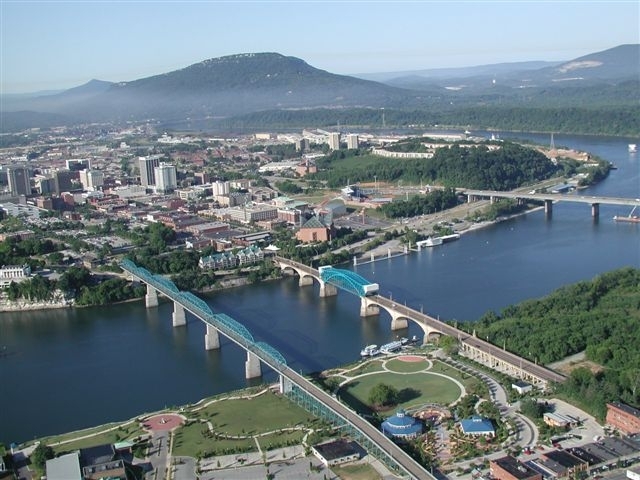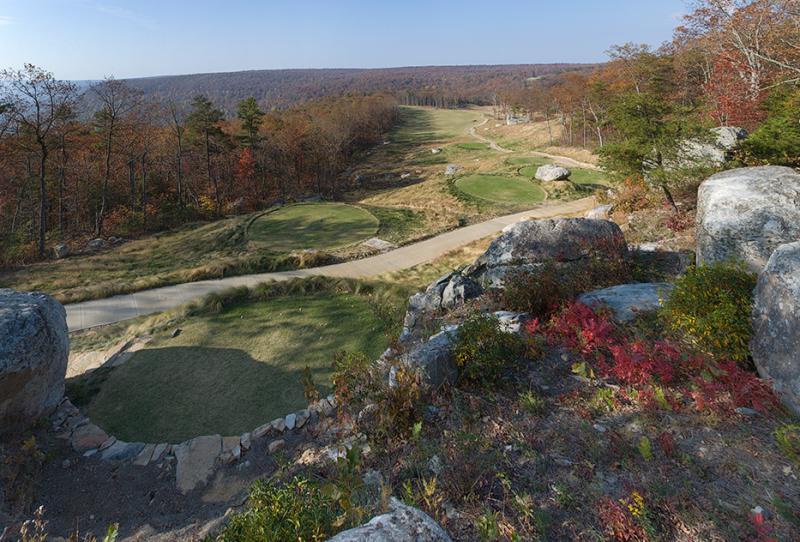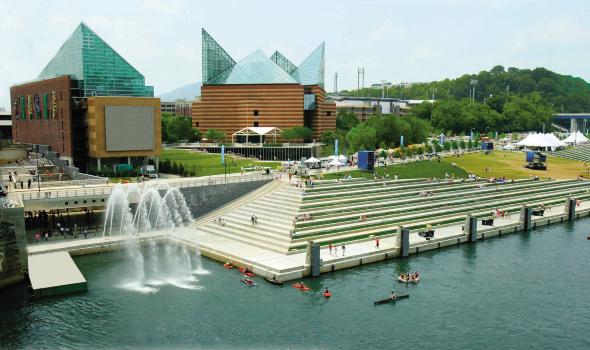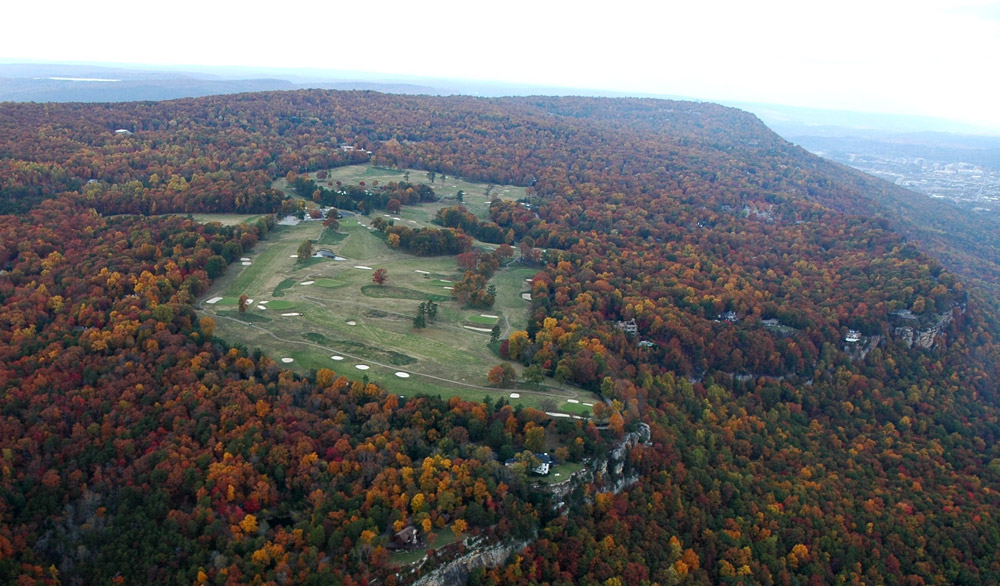
The (now) quite lovely city of Chattanooga sits at a dramatic meeting of land (Lookout Mountain) and water (the Tennessee River).
In 1969, during a CBS evening news broadcast, Walter Cronkite reported that the EPA had just named Chattanooga “the dirtiest city in America” for its onerous air pollution.
Today it’s difficult to imagine any such physical blight. Geologically, Chattanooga is one of the South’s most well endowed cities, poised as it is at a dramatic confluence of land and water at a point where the Tennessee River carves gorges into the southern Cumberland Plateau in a series of sharp twists and buttonhooks.
Bracketing the river, the city surges upward from both banks into the surrounding foothills, while Lookout Mountain, a tall, sheer-faced plateau stretching well into Georgia and northeast Alabama, culminates at a sharp point overlooking downtown Chattanooga.
Furthermore, Chattanooga has undergone a spectacular civic renaissance in the last 20 years, investing over $2 billion in improvements and utterly wiping out any trace of environmental embarrassment. $120 million alone has been spent revitalizing the polluted riverbank and creating parks, green space and a 10-mile walking trail.
Forty years after the Cronkite report, the Chattanooga of today is a remarkably family-friendly city offering almost more to do than can be accomplished in a just few days. A range of sightseeing destinations and Civil War sites are located atop Lookout Mountain. Along the river there are sporting activities, guided water day-trips and outdoor excursions. And the surrounding historic neighborhoods and enclaves are full of artisan and bohemian activity and an up and coming restaurant scene that may eventually grow to rival the best in the Southeast.
Of course, Chattanooga’s geographical diversity also provides a rich backdrop for golf. While better known for a lineup of esteemed private clubs there are enough publicly accessible courses to make the area a proper golf destination.
An exciting introduction to Chattanooga’s unique landscape is Canyon Ridge Club, located a 30 minutes drive south of the city. The golf course, designed by Rick Robbins of North Carolina in 2005, is set within of an upscale second home community atop Lookout Mountain, parts of which sit overlooking dramatic precipices with views that go on for miles.

Several holes at Canyon Ridge, like the first (above), showcase stunning views off the eastern edge of Lookout Mountain.
Two holes—the first and 18th—run along the edge of the mountain, and approach shots pulled left of either green fall 1,000 feet straight down to McLemore Cove below. Away from each of these stunning spots the holes hold your attention with varied lengths and presentations as they run through varying settings of forest and meadow, with rock outcroppings, streams and gullies intervening at different junctures.
The finest holes, in fact, are those that simply ride the gentle terrain shifts—the par five 12th moving first right, then left with the land toward the elevated green; the 14th, rising upward through a wide meadow, the terrain sloping right to left; and the par five 17th that sweeps grandly down through a wide boulevard of pines. Even when the routing hits trouble spots—the par five sixth, with first and second shot landing areas separated by a gulch and a 70-foot drop—it remains entertaining, and Robbins’ understated architecture gives top billing to the property and surrounding scenery.
Ten miles west of downtown Chattanooga is Eagle Bluff Golf Club, located on a high peninsula above the Tennessee River. Designed by Atlanta-based architect Bill Bergin, the course rolls around an abruptly shifting and heavily forested site cut by ravines and wetlands.
The up-and-down nature of the course makes for unpredictable golf and this property is not for the faint of heart—narrow fairways, especially on the first nine, tilt and drop off into danger zones, and the land, interestingly, appears not to have been softened or graded much.
Playing here feels a little like walking a tightrope in a heavy sea wind. Several drives play blindly over the crest of hills and holes such as the 430-yard sixth and 435-yard 14th display extreme if however natural fairway contour. Respite, at last, comes at the greens, eighteen modestly shaped moments of lovely grace against an otherwise roiling tide.
The Bear Trace at Harrison Bay Golf Course, one of four Jack Nicklaus Signature Bear Trace course on the Tennessee Golf Trail, is located in a state park on the banks of a large reservoir section of the Tennessee River formed by Chickamauga Dam, about 30 minutes east of the city.
Unlike Eagle Bluff, Harrison Bay flows gracefully and gradually through a placid parkland setting (rather than a neighborhood) of pine and hardwoods, with eight holes either touching or opening onto aspects of the lake. Though not overly shaped—certainly not by Nicklaus Design standards—the greenside features and strategies here show much more flair than your typical state park-based course.
Nicklaus’s fairways here are enormous and accommodate different approach angles into large greens perched up on platforms or benched into landforms. Deep, grass-faced bunkers—Raynor-esque in ways, a seldom-used format for the firm, and one that works well against the understated land—cover the greens from less ideal lines of attack.
After a foray to the lake at the par three 14th, a 176-yard hole calling for a carry over an inlet, the next three holes turn inland into some of the most alluring land on the property, The par four 16th, climbing uphill to a green benched behind two deep-set bunkers, is a particularly powerful hole that could easily belong to a 90-year-old club in the Northeast. The 18th returns to the shoreline with a 434-yard dogleg bending left over a crest before falling down to a green tucked at the water’s edge.
Chattanooga’s best golf is private, highlighted by one of the Southeast’s outstanding players clubs, The Honors Course. Built to honor the amateur game, the highly ranked Pete Dye course has hosted the U.S. Amateur and Mid Amateur as well as regional and collegiate championships. The Honors is highly exclusive, so you’ll need good contacts to work your way inside.
One of the most historic and intriguing clubs in the immediate region is Lookout Mountain Golf Club located on the eastern flank of Lookout Mountain. This was the last course designed by Seth Raynor before he died in 1926 (Charles Banks worked with him, finishing the construction), but due to economic hardships at the time the course was never completed at Raynor envisioned it.
It sat relatively untouched for decades except by general maintenance and wear, until Brian Silva restored many of the eroded greensite features and installed over 50 bunkers that were once planned but never built. Though short and quaint, this is on of the most charming courses in the Southeast, full of strategic architecture, hazardous green surrounds and distant views off the mountain into the surrounding valley. The guest policy is not overly stringent and getting access is not impossible with a good connection.
If there’s a “blue blood” club in the city, it’s the Chattanooga Golf & Country Club. The 1920 Donald Ross-designed course, and the newly renovated clubhouse, sit on a beautiful property on bluffs over the Tennessee River just north of downtown. Bill Bergin renovated the course in 2005, returning and improvising much of its lost Golden Age character. Another popular club, Council Fire, designed by Bob Cupp, was the host course for a PGA Tour event, the Chattanooga Classic.
Black Creek Golf Club, a short drive west of downtown on I-24, is the current host of the Chattanooga Classic, now a Nationwide tournament. It’s also the site of some of Tennessee’s most vividly rendered architecture, a Brian Silva-created homage to the shapes and strategies of Seth Raynor (and indirectly to Raynor’s mentor C.B. MacDonald).
Black Creek is what Lookout Mountain might have looked like if Raynor could have ushered it through to completion. Opened in 2000 and part of a tasteful though sizable real estate development (the homes have steadily filled in over the last decade, primarily on the first nine; the second is largely, blissfully, alone), the private club is operated by Troon Golf, though members of any club in the Troon Advantage program (there are dozens across the country) can gain access to the course
The trick for Silva here was to locate which parts of this scenic property—really a valley floor below a horizon of tree-covered ridges—could best accentuate particular Raynor template holes and his unique engineered look. The finished presentation is profound as Silva built holes into the elevation changes and natural contours to create a series of holes that are each individually crisp, angular and full of visual contrast.
Standouts include the downhill 165-yard fourth (Raynor’s “Short” hole), the 239-yard 7th (a monstrous reverse Redan) and the 347-yard 15th with a green nuzzling a wetland area (“Cape”). The blind punchbowl green at the par five sixth, at over 14,000 square feet, is one of the largest putting surfaces anywhere, but the most amazing hole at Black Creek is the 206-yard 17th with its full-scale, gallery-piece Biarritz green.
Black Creek’s architecture is certainly intriguing and fun, but simply walking the gorgeous property, looking up at the surrounding ridges and Lookout Mountain in the distance, puts an exclamation point on how memorable and diverse—and interesting for golf—the earth is around Chattanooga.
STAYING
A sensible choice in the downtown area is The Chattanoogan Hotel, a modern hotel and conference center located near the Warehouse Row district and just 11 blocks from the waterfront. A few blocks closer to the waterfront is the Sheraton Reed House Hotel, an historic 10-story building built in 1926. The lobby décor is a combination of Jazz Age aesthetics (quarter sawn walnut paneling, Terrazzo floors inlaid with marble, 1920’s era sit-in phone booths and mail chutes connected to the upper floors) and 21st century convenience (i.e., an attached Starbucks).
Another options is the Bluff View Inn, an upscale bed and breakfast just a short walk to the downtown district. The Inn is located within the Bluff View Art District, a development situated on an 80-foot embankment overlooking the Tennessee River with restaurants, café’s, galleries, plazas and courtyards. It’s adjacent to the Hunter Museum of American Art, a profound modernist structure built by architect Randall Stout in 2005 exhibiting works from American luminaries such as Cassatt, Hopper, Homer, Warhol, Whistler and Wyeth.
EATING
If you stay overnight at Canyon Ridge Club (accommodations include rental condominiums and beautiful show homes), or are just staying late after the round, don’t miss Canyon Grill. It’s located about five miles away in an unassuming building off the side of the highway where chef and owner Lawton Haygood serves cuts of beef, poultry, trout and salmon cooked over a specialized mesquite-fired grill he personally designed. The showcase menu item, however, is the Slash n’ Burn, a whole bone-in fried catfish injected with ginger, garlic and jalapeños and topped with a spicy black bean sauce.
In Chattanooga, near Warehouse Row, is St. John’s Restaurant occupying the space of a former hotel and brothel. Here, in an elegant two-level dining room, Chattanooga native and chef/owner Daniel Lindley (who previously did tours at Gramercy Tavern and in the Hamptons in New York) serves a seasonal farm-to-table menu that leans heavily on daily-procured ingredients from Chattanooga area farms. For a nightcap walk next door to the adjacent Meeting Place, St. John’s sister restaurant that offers lighter fair and a more upbeat scene at the upstairs bar.
Just a block from the waterfront is Easy Bistro, set inside a large, airy room with a great bar, raw bar, shellfish platters and a menu that includes southern-tinged French bistro classics like steak frites, macaroni au gratin, roast chicken grand-mere and Cote de Boeuf for two.
For breakfast (or evening beers) cross over the river (by car, or by the Walnut Street pedestrian bridge) to Aretha Frankenstein’s, a kitschy-cool restaurant in the hip North Shore district. Served in a cozy room with pop culture, rock and punk memorabilia adorning the walls, the huge breakfast portions include Slim or Fat Stack Pancakes, airy Belgian waffles called the Elephants Gerald, ten different omelets, and SuperDave’s Scramble with jalapeños, mushrooms and potatoes.
For something quick try Petunia’s Silver Jalapeño, a gourmet roadside trailer just two miles north of downtown off Signal Mountain Road. The food is casual and kitschy but seriously good, including “Laura’s Love” fish tacos and “Petunia’s Smoked Butt” sandwich.
ENJOY
The Georgia Aquarium, the world’s largest and located two and half hours down the interstate in Atlanta, opened in 2005, but the Southeast’s original blockbuster fish fantasy is Chattanooga’s Tennessee Aquarium (opened in 1992), still the world’s largest freshwater aquarium. To many it remains the preferred of the two. The dual striking steel, brick and glass structures—River Journey and Ocean Journey, respectively—sit side-by-side directly on the downtown riverfront.
Lookout Mountain is the site of several tourist activities. In the warmer months you can spend a morning at Lookout Mountain Hang Gliding, considered one of the country’s best hang gliding schools and launching points, watching gliders push off the concrete radial ramp and soar over above the distant valley floor.
Take the Incline Railway—a mile-long ride that clings to the side of the mountain at an incline of 72.7 degrees, billed as the world’s steepest—to the Civil War historical sites at the top of Lookout Mountain. There’s also Rock City on the mountain’s eastern slope with trails, gardens and beautiful promontory perches that allow you to see parts of seven different states. Another popular attraction is Ruby Falls, a dazzling 145-foot underground waterfall located in a cave inside Lookout Mountain.






